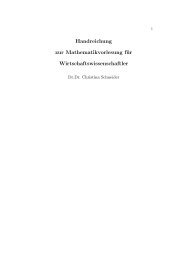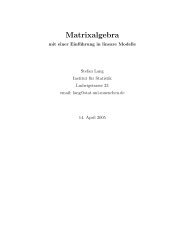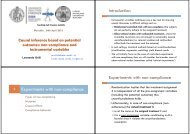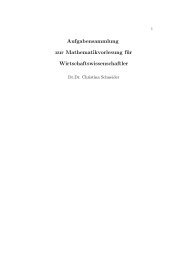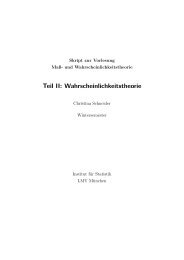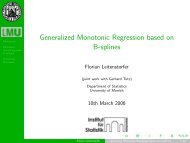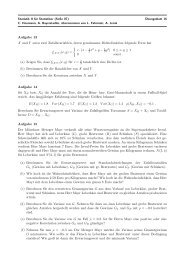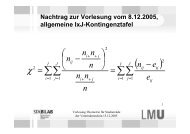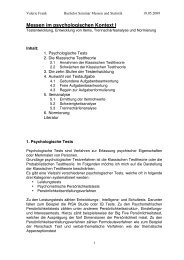Create successful ePaper yourself
Turn your PDF publications into a flip-book with our unique Google optimized e-Paper software.
4.2 Basic principles of using the cv.<strong>lqa</strong>() function 18<br />
with tuning parameter λ. Using a loss function L(y i , ˆµ λ i ) the cross-validation function is<br />
CV(λ) = 1 K<br />
K∑ ∑<br />
L(y i , ˆµ λ i ).<br />
k=1 i:κ(i)=k<br />
This definition varies from the typical ones such as (7.49) in Hastie et al. (2009), p. 242.<br />
But from a computational point of view it is more well-arranged. This will become clear,<br />
hopefully, in the examples below. The loss functions already implemented in the <strong>lqa</strong><br />
package are summarized in Table 4.<br />
Criterion Formula Function name<br />
AIC AIC(λ) = Dev k λ +2 tr(H −k<br />
λ ) aic.loss()<br />
BIC BIC(λ) = Dev k λ + log(n) tr(H −k<br />
λ ) bic.loss()<br />
GCV GCV(λ) = n Dev k λ /{n − tr(H −k<br />
λ )}2 gcv.loss()<br />
squared loss SL(λ) = ∑ n<br />
i=1 (y i − ˆµ λ i ) 2 squared.loss()<br />
deviance loss DL(λ) = Dev k λ dev.loss()<br />
Table 4: Implemented loss functions.<br />
Note, if loss.func = gcv.loss is chosen then this does not match with given validation<br />
data. This is due <strong>to</strong> the construction of the GCV as an approximation <strong>to</strong> leave-one-out<br />
cross-validation. If there are nonetheless given some validation data then cv.<strong>lqa</strong>() will<br />
replace them by the training data arguments y.train and x.train.<br />
ˆb<br />
−k<br />
λ<br />
However, the estimate are part of the output of <strong>lqa</strong>(). But<br />
<strong>to</strong> compute terms like Dev k λ and ˆµ λ i the <strong>lqa</strong> package provides the function predict.<strong>lqa</strong>().<br />
This function is primarily used internally, but you can use it directly as well. See the <strong>lqa</strong><br />
manual (Ulbricht, 2010a) for documentation of it.<br />
The function predict.<strong>lqa</strong>() returns an object pred.obj of the class pred.<strong>lqa</strong>. This<br />
object is the input argument for all loss functions in <strong>lqa</strong>. Therefore it is worth <strong>to</strong> look<br />
at it a little bit more closer. The object pred.obj contains the following elements<br />
deviance<br />
tr.H<br />
n.newobs<br />
eta.new<br />
and the hat matrix H −k<br />
λ<br />
the deviance based on the new observations. This element<br />
provides Dev k λ.<br />
the trace of the hat matrix of the design matrix used <strong>to</strong> fit the<br />
model, e.g. H −k<br />
λ<br />
. This is just an extraction from the <strong>lqa</strong>.obj<br />
object that is used as input argument in predict.<strong>lqa</strong>().<br />
the number of new observations.<br />
the estimated new predic<strong>to</strong>rs.<br />
mu.new the estimated new responses, e.g. a vec<strong>to</strong>r containing ˆµ λ i .<br />
<strong>lqa</strong>.obj<br />
new.y<br />
the <strong>lqa</strong>.obj argument of the predict.<strong>lqa</strong>() function. This is the<br />
return object of the <strong>lqa</strong> function, so that you can in principle<br />
access all of its elements.<br />
the vec<strong>to</strong>r of new observations.



